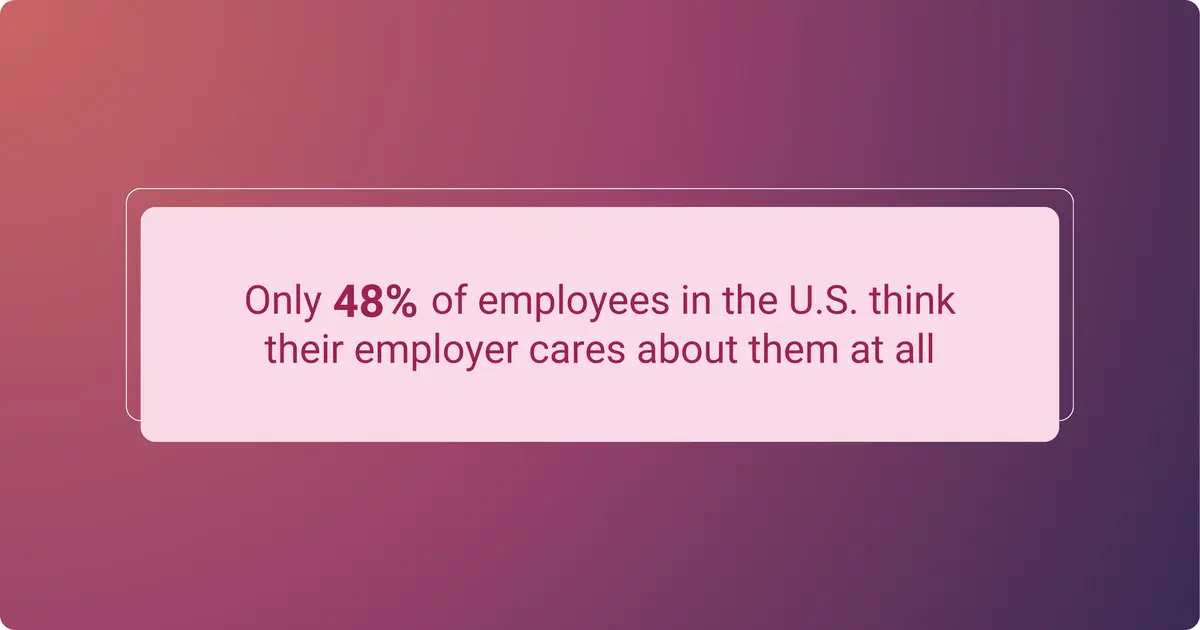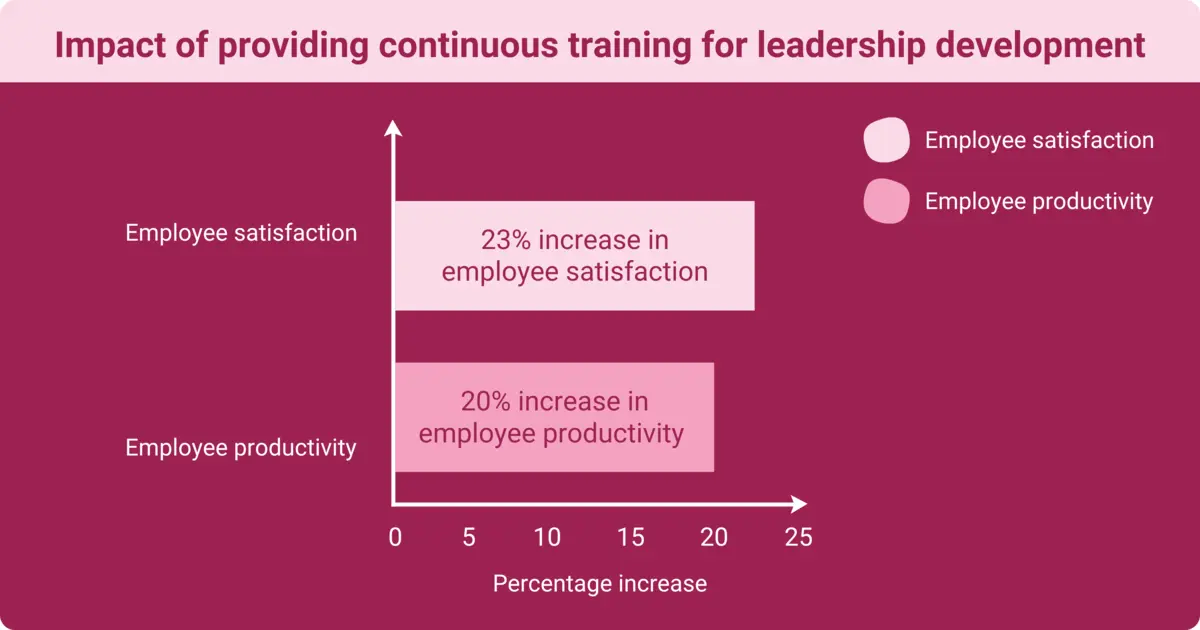Purpose-Driven Leadership: What It Is and How It Transforms Organizations
Table of contents
- What is purpose-driven leadership?
- Purpose-driven vs. servant leadership: Key differences
- What are the benefits of purpose-driven leadership?
- Key characteristics of purposeful leaders
- How to cultivate purpose-driven leaders in your organization
- Purpose-driven leadership is how you turn vision into reality

When an organization leads with a clear purpose, it means a more satisfied workforce and higher growth and productivity rates. According to a Deloitte study on how purpose-driven brands are transforming businessOpens in a new tab, companies that understand their organizational purpose have 30% higher levels of innovation and 40% higher levels of workforce retention.
So what is purpose-driven leadership, why is it important, and how can you implement it in your workforce?
What is purpose-driven leadership?
Purpose-driven leadership is when leaders inspire and motivate their teams not just through tasks and responsibilities, but by connecting those actions to a larger mission and set of values.
This leadership style leads to more innovation, better business outcomes, increased resilience, more meaningful connections, higher rates of attracting and keeping talent, and improved employee productivity.
Many companies have adopted a purpose-driven approach. Procter & Gamble uses storytelling to highlight issues related to its goal of becoming a force for good for growth. With the knowledge that its products reach more than 5 billion people around the world, the company developed policies to address unconscious bias, equality, and diversity to better connect with customers on a deeper level.
Another example of a purpose-driven company is Patagonia. A globally respected and admired brand, this outdoor clothing and gear maker passionately believes in sustainability and preserving the environment.
To align its practices with its purpose, the company only uses organic suppliers and donates 10% of its profits or 1% of its sales (whichever is larger) to environmental causes. Even as it encourages customers to minimize their purchases, Patagonia has continued to grow.
To better understand purpose-driven leadership, let's look at the differences between it and servant leadership.
Purpose-driven vs. servant leadership: Key differences
In purpose-driven leadership, employees are told that they are in the game to make an impact and that it aligns with their own purpose in the organization. Servant leadership focuses more on how an employee serves others.
Here are a few examples of questions either may ask:
- Service: How can I help you be successful?
- Purpose: What help will you need to be successful?
- Service: Does this work for you?
- Purpose: How will this affect our customers or team members?
- Service: Who needs coaching the most?
- Purpose: Where will my mentoring be most impactful?
Younger workers, the future of the workforce, want to work for a company with a purpose behind its vision. They want to see a positive impact on the world through their work, resonate with the organization's core values, and be treated like they matter.
A dismal statistic from Fast Company highlighting the opportunity for employers to refocus on employee wellbeingOpens in a new tab shows that only 48% of U.S. employees believe their employer cares about them. Purpose-based leadership can help change that.

What are the benefits of purpose-driven leadership?
When this leadership style is perfected, teams are stronger, individual employees are more resilient, and it is easier to build a strong culture and enhance your company's identity and reputation. Employees are also attracted to companies with a purpose, and you're more likely to keep skilled talent around when they’re invested in your organization’s values and goals.
Increases employee engagement and productivity
A positive workplace culture is one benefit of providing employees with direction and meaning. According to Gallup, only 2 in 10 employees in the United States feel their coworkers care about the company’s cultural views. So what is the purpose of leadership, if not to make employees feel connected in a way that leads them to follow your vision?
Engagement in the workplace is measured by employees' willingness to go above and beyond – not to take advantage of them but to see them connect with your values. On the other hand, workers who are disengaged are more likely to negatively influence coworkers, drive customers away, miss workdays, and steal from the company.
At Workhuman®, we use the four Es of employee engagement to enhance company culture:
- Enablement: Enable your employees to engage by providing them with the tools and support necessary to do their jobs efficiently and positively.
- Energy: Rather than expecting more output, focus on your employees’ physical, emotional, mental, and spiritual energy to improve engagement and performance.
- Empowerment: The foundation of accountability, empowerment requires the employee to make decisions and employ resources by keeping them productive and engaged.
- Encouragement: Encouragement and recognition cost nothing in the form of a quick word or short email but give employees the courage to go beyond their minimum job requirements.
Drives innovation and creativity
When employees are focused on a greater purpose rather than just an individual job, they have more freedom to think outside the box. As a leader, you task them with sharing a vision.
This fosters psychological safety so that employees choose to open up and share ideas without being looked down on. They’re empowered to take risks because they have the autonomy, support, and resources to mess up but keep trying.
Helping employees understand the value of a growth mindset can energize them about opportunities to learn and develop. Purpose-driven leaders foster a culture of collaboration and open communication, emphasizing the importance of each individual’s ideas.
One standout example is Warby Parker, the online eyewear retailer. From the start, their mission was clear: provide stylish, affordable prescription glasses while making a positive social impact. By adopting a direct-to-consumer model, they cut out the middleman, reduced costs, introduced a home try-on program, and committed to donating a pair of glasses for every one sold.
This innovative approach allowed Warby Parker to stay true to its purpose - making vision accessible to all, including those who can't afford it.
Improves strategic decision-making
Looking at a “bigger mission” than the one you’re currently working on improves strategic decision-making. It enhances clarity and consistency in every decision. Daily action links directly to overarching goals by strengthening accountability and streamlining resource allocation.
Perhaps one of the best examples is the United States Nuclear Submarine Force. The U.S. Navy is tasked with ensuring global security and defending the nation, a broad goal that involves millions of daily decisions.
Every crew member has a unique role that supports the overall objectives, whether executing strategic maneuvers, maintaining equipment, or conducting covert missions. The organization emphasizes accountability, excellence, and integrity through rigorous, purpose-driven leadership training.
Enhances long-term financial performance
At its foundation, every business needs financial success to stay viable. Purpose-driven leadership helps drive that success by fostering customer loyalty, building brand trust, and boosting financial resilience. When customers buy into your vision, they’re often willing to spend more to stick with your brand.
Take Best Buy as an example. At one point, the company was struggling and widely seen as a sinking ship. But instead of resorting to cost-cutting alone, the new CEO redefined the company’s purpose: to enrich customers’ lives through technology. He shifted the mindset from chasing profit to creating meaningful value, treating profit as the outcome, not the goal.
The strategy paid off. Best Buy doubled its online sales and achieved five straight years of revenue growth.

Key characteristics of purposeful leaders
Purpose-driven leaders are focused on specific things, such as visionary thinking, empathy and emotional intelligence, employees’ and company’s best interests, resilience when things aren’t going well, effective communication and transparency, creative problem-solving techniques, and relationship building.
Visionary thinking
Visionary thinking starts with the big picture and then breaks that overall goal down into daily tasks that help you achieve that goal step by step.
When your employees are working toward a bigger goal, the menial day-to-day tasks have more purpose and energy behind them.
Emotional intelligence and empathy
Emotional intelligence and empathy are two of the most important qualities a purpose-driven leader can have. The ability to understand your employees, truly value their input, and see where they fit into your vision builds workplace trust and stronger connections. As employees become more comfortable opening up, they share even more ideas.
Resilience in uncertain times
Every project, from a major launch to a new team formation, is bound to have hiccups. A purpose-driven leader sees past those bumps and doesn’t let them derail the company. This is because they aren’t as focused on the individual steps as they are on the prize at the top of the staircase.
Effective communication and transparency
Open and transparent communication fosters trust and credibility, boosts authenticity, and reinforces reliability A shared vision is inclusive, clear, and appreciated. This drives empowerment, motivation, and creativity. Address all issues head-on so your workforce knows there’s no “back-talk” happening.
Conflict resolution and relationship building
All relationships have their share of conflict, and even the best of friends in the workplace are bound to have disagreements. Conflict resolution is a vital skill that every organization needs.
If employees know they can disagree healthily, they’re more likely to approach different perspectives or suggest alternative ideas. With a supportive culture, employees focus on meaningful work, obtain a better understanding of the objectives, and feel empowered to grow and make decisions, even as they mess up and gain self-awareness.
How to cultivate purpose-driven leaders in your organization
Now that you understand the benefits of purpose-driven leadership and its importance, how do you implement these strategies in your organization? Here are key tips.
Establish clear purpose and vision statements
Make sure your leaders understand the organization’s purpose and vision so they can pass it down. A clear and compelling purpose statement creates a strong foundation for every leadership interaction.
Identify key drivers of purpose in leadership
Consider what key attributes drive purpose-driven leadership. Find leaders who care about these things, too. These include shared organizational values, employee well-being, empowerment, leadership modeling, and a sense of purpose and community.
Align purpose with performance metrics
Your Key Performance Metrics (KPIs) should be in alignment with your company’s overarching purpose. This allows for better resource allocation as you realize which metrics contribute to the company’s overall purpose and provides a clear objective to employees.
Metrics also give valuable insight into company performance before big decisions. They provide targeted and continuous improvement, professional development, as well as better operational efficiency.
Put your purpose into action
Leading with purpose is focused on the big picture, and the day-to-day tasks and conversations lead to that goal. Every decision, policy, procedure, and practice must align with the company’s values.
For example, a study by Forbes on stagnating employee engagementOpens in a new tab points out that if your company’s purpose is employee engagement and wellness, requiring employees to work at a desk for eight hours a day isn’t a policy that supports that agenda.
Provide continuous training for leadership development
Good employees and leaders come from organizations that provide continuous learning and education opportunities. Businesses that make this a priority show a 20% increase in employee productivity with a 23% increase in employee satisfaction. The correlation is clear. Employees who are happy at their jobs are more productive, showing how education is an investment with a solid return on investment.

Recognize purpose-driven wins and milestones
Praising and recognizing employees when they have milestones that align with your company’s purpose is one of the best ways to build community and increase morale. Research shows that when companies double their recognition efforts, they see a 9% increase in productivity, with the technology, finance, and insurance industries seeing the most benefits.
These numbers show that social recognition and positive feedback are crucial to the company environment. The more your employees feel appreciated, the more they will buy into your vision and shared purpose.
Encourage continuous feedback
The purpose of a leader is to help employees grow and succeed so the company can thrive, so don’t stop the feedback circle. Employees who don’t receive regular feedback often feel lost or isolated.
Continuous feedback ensures that employees are on the right track to reach their ultimate goal, gives you a chance to brainstorm with different people, and allows you to highlight the company’s purpose.
Here are six tips to be a good manager and build a feedback loop:
- Flip the focus and look at the future instead of the past
- Give feedback about learning rather than reprimanding
- Keep it positive and be aware of the power imbalance between manager and employee
- Provide fast and frequent feedback so employees know you see their work and can fix problems quickly
- Use peers to provide feedback or coaching to create a team mentality
- Leverage technology like Workhuman’s Conversations™ to aggregate feedback
Purpose-driven leadership is how you turn vision into reality
Purpose-driven leadership isn’t just a feel-good philosophy, it’s a practical, high-impact strategy for building stronger teams, bolder ideas, and better business outcomes.
By connecting daily work to a larger mission, you create a culture where employees are more engaged, more innovative, and more resilient. The result? Greater retention, smarter decision-making, and long-term financial success.
In an era defined by remote work, AI disruption, and shifting employee expectations, purpose is your competitive advantage. It’s what turns managers into mentors, strategies into stories, and companies into communities. And with the right mix of data, empathy, and leadership development, you can cultivate a workforce that’s not just productive - but deeply aligned with why the work matters in the first place.
Lead with purpose. The future of work depends on it.